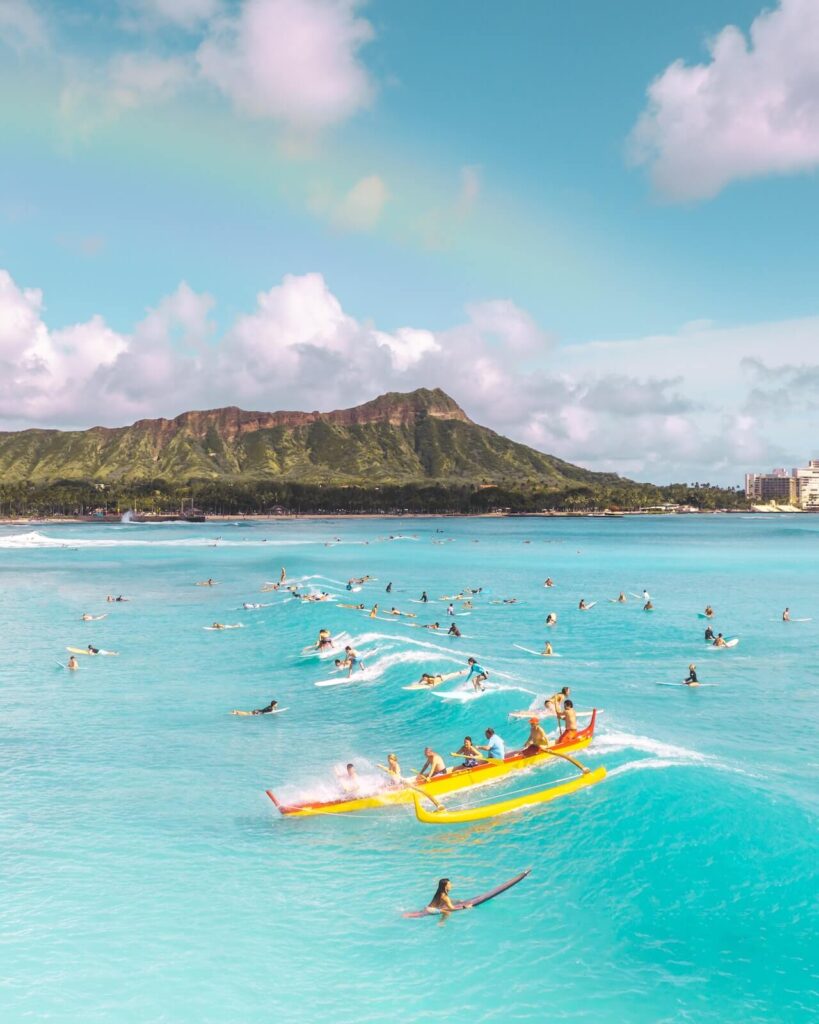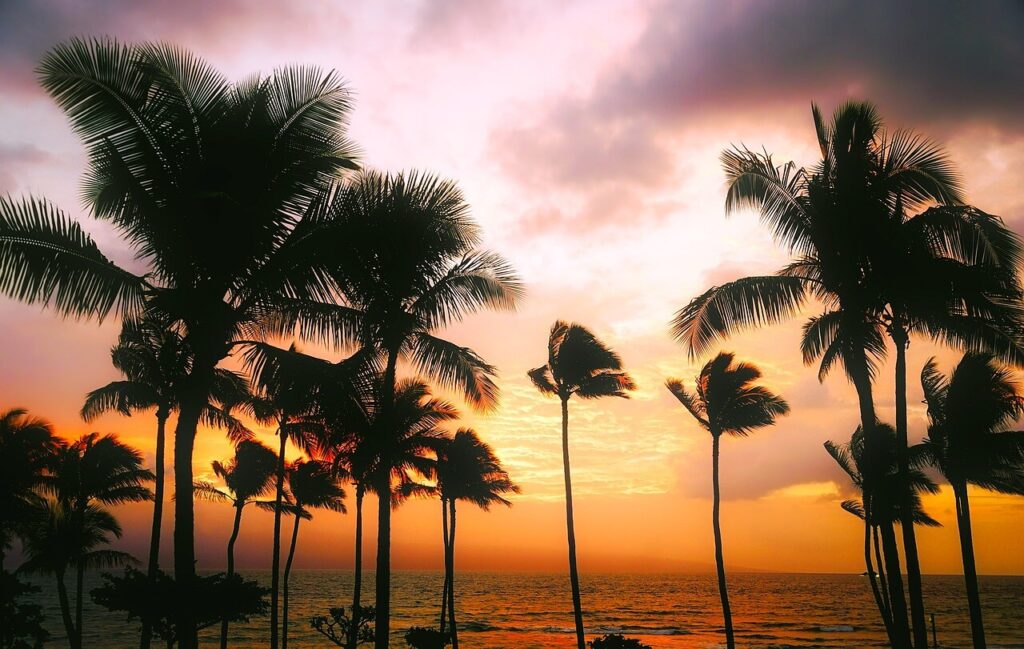Ocean Safety in Hawaiʻi (Including Tips For Waikiki Beach!)
Published on - 2023-06-15
While Hawai’i is certainly one of the most beautiful places in the world to go snorkeling or try your balance on a surfboard, the Pacific Ocean is powerful and deserves your full respect. You should always use common sense and take basic precautions. By practicing the following tips, most visitors will find that it’s safe to swim in Hawai’i.
1. Mind the Weather
Hawai’i is world-famous for sun-soaked beaches and outdoor attractions, but that doesn’t mean we don’t have stormy days! High winds make for high waves that are dangerous for beachgoers. Always pay attention to warning signs about high surf. It’s not safe to swim when a storm system brings in extra water. Similarly, avoid taking a boat out during a wind or storm advisory.
2. Face the Horizon, Not the Shore
A good safety tip in Hawai’i is to never turn your back on the ocean. Waves can surprise you, and a large wave can appear suddenly after several smaller ones. The safest approach for a big wave is to duck under it. If you aren’t a confident swimmer, don’t move out so far that you can’t touch the bottom.
3. Have First Aid Ready
The warm, wet environment of the shoreline is perfect for bacterial growth. Slippery concrete, rock, and coral surfaces can cut your skin if you lose your footing. If you cut yourself, clean and dress the wound promptly to avoid infection. Waikiki Beach has lifeguards with first aid kits for minor injuries, but if you’re swimming elsewhere, it’s safe to bring your own supplies.
4. Watch for Riptides
Riptides and fast-moving currents can be dangerous. They may form around constructions like jetties and breakwaters, and you may not know they are present until you are caught in them.
If you find yourself caught in a strong current or a riptide, swim at an angle toward the shore. For example, if you’re being pulled to your left, don’t try to swim to your right directly against the current. Instead, let the current still take you left while you angle toward the shore. Try not to exhaust yourself by fighting the current.
5. Swim in Marked Areas
If you want to go snorkeling, we recommend Hanauma Bay! No matter where you go, it’s safest to swim on a marked beach with lifeguards present. Never swim alone.

Ocean Wildlife Safety
Hawai’i attracts divers from around the world. Swimming in the ocean can treat you to amazing sights, and you may see many forms of marine life and endangered species.
Unfortunately, negative encounters with nature get much more attention than good or neutral encounters, especially in the press. Exaggerated stories may lead some to think it is not safe to swim at places like Waikiki Beach. Millions of tourists would say otherwise, however.
The safest visitors and island residents observe the following rules and precautions to maximize their enjoyment of the sea and the sun.
Sharks
The saying is true — they are more afraid of you than you are of them. Most sharks will go out of their way to avoid swimmers, but it’s certainly possible that you will still encounter one. Hawai’i has about 40 shark species, and a handful of them will swim near the shoreline.
Visitors can decrease their chance of having an unplanned encounter with a shark by following these ocean safety tips:
- Always check for shark sightings, notices, and warnings.
- Don’t wear loose, dangling apparel or glittery jewelry in the water. It may lure a shark.
- Don’t go swimming at dusk, dawn, or night. Sharks may be more active at this time.
- Don’t swim in areas where freshwater mixes with saltwater, like river and stream inlets. Sharks may be attracted by the warmer water and abundant prey and be more aggressive.
- Don’t enter turbid or cloudy water. If a shark can’t see you, it may “bump” you out of curiosity.
Don’t let fear of sharks keep you off the beach. The number of surfers who flock to Oahu every year is a good indication that it can be safe to swim in the ocean around Hawai’i. Most of those who depend on the sea for their income would agree. As long as you observe the rules and use common sense, it is safe to swim at beaches like Waikiki.
Jellyfish
Box jellyfish and Portuguese man o’ war form a vital link in the food chain, but an encounter with one of these animals can result in a painful sting. To avoid being stung, do not touch them, and watch where you step when you walk on the beach, especially when it is dark.
Knowing how to handle jellyfish stings is a necessary part of any well-rounded ocean safety course in Hawai’i. If you are stung, avoid touching the affected area. If the jellyfish or a bit of it is still on you, remove it with something other than your bare hand — a sandal or beach towel can work — to avoid it stinging your skin again.
Most jellyfish stings are minor. Vinegar may help neutralize the poison, and ice may help with the pain.
Sea Turtles
No matter which Hawaiian island you travel to, you’ll have a good chance of a sea turtle encounter. Although you’ll want a picture, stay at least ten feet away. Sea turtles are endangered and protected by law. You could be cited for a federal or state violation for disturbing the turtle’s natural movements. Sometimes a sea turtle will look ill or injured from a distance. It likely isn’t — turtles simply move slowly on land. If you do believe a turtle is in danger, still don’t approach it. Call the NOAA hotline at (888)-256-9840.
Monk Seals
You’re far less likely to see a monk seal than a turtle, but, if you do, take similar precautions. Monk seals are critically endangered and should only be approached by trained professionals. The NOAA recommends a monk seal viewing distance of at least 50 feet (15 meters) away on land and in water and at least 150 feet (45 meters) away from a mother seal and her pup. Remember to also stay behind any signs or barriers that have been placed around the seal.
Whales and Dolphins
If you happen to see a whale or a dolphin while swimming in shallow water in Hawai’i, it is not safe to approach it. When a larger animal comes this close to shore, it’s often because it’s injured, and its behavior may be erratic. Swim away and call the NOAA at (888)-256-9840 when you return to shore.

Is It Safe To Swim At Waikiki Beach?
Ocean safety in Hawai’i, at Waikiki Beach and elsewhere around Oahu, depends to some extent on personal responsibility and common sense.
Speedboats and personal watercraft may come close to protected swimming areas, and people in boats may have a hard time seeing people in the water. Do not assume that they can see you. Rafts and diving platforms can change position unpredictably, so if you are surfacing from a dive always look up to make sure there are no obstructions.
If you are on a boat or a personal watercraft, observe all the safety precautions and follow all the rules.
You can find information about current beach conditions and learn more about ocean safety in Hawai’i at HIOceanSafety.com.
Have A Great Experience in Hawai’i
While natural hazards may always be present, these tips may help you join the millions of travelers who have found it is safe to swim in Hawai’i and at Waikiki Beach.
As you think about ocean safety in Hawai’i, don’t overlook your transportation. Get to your destination faster with a premium sedan, convertible, minivan, or SUV rental from GoVibe. We meet you at the airport for a fast and hassle-free pick-up at an affordable rate. Check availability to book your vehicle with free cancellation and superior service.